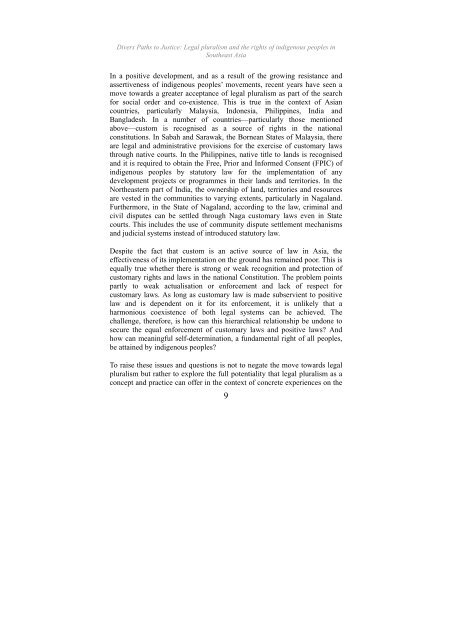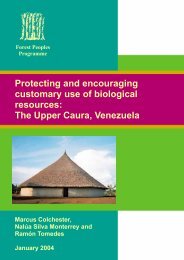Divers Paths to Justice - English - Forest Peoples Programme
Divers Paths to Justice - English - Forest Peoples Programme
Divers Paths to Justice - English - Forest Peoples Programme
Create successful ePaper yourself
Turn your PDF publications into a flip-book with our unique Google optimized e-Paper software.
<strong>Divers</strong> <strong>Paths</strong> <strong>to</strong> <strong>Justice</strong>: Legal pluralism and the rights of indigenous peoples inSoutheast AsiaIn a positive development, and as a result of the growing resistance andassertiveness of indigenous peoples’ movements, recent years have seen amove <strong>to</strong>wards a greater acceptance of legal pluralism as part of the searchfor social order and co-existence. This is true in the context of Asiancountries, particularly Malaysia, Indonesia, Philippines, India andBangladesh. In a number of countries—particularly those mentionedabove—cus<strong>to</strong>m is recognised as a source of rights in the nationalconstitutions. In Sabah and Sarawak, the Bornean States of Malaysia, thereare legal and administrative provisions for the exercise of cus<strong>to</strong>mary lawsthrough native courts. In the Philippines, native title <strong>to</strong> lands is recognisedand it is required <strong>to</strong> obtain the Free, Prior and Informed Consent (FPIC) ofindigenous peoples by statu<strong>to</strong>ry law for the implementation of anydevelopment projects or programmes in their lands and terri<strong>to</strong>ries. In theNortheastern part of India, the ownership of land, terri<strong>to</strong>ries and resourcesare vested in the communities <strong>to</strong> varying extents, particularly in Nagaland.Furthermore, in the State of Nagaland, according <strong>to</strong> the law, criminal andcivil disputes can be settled through Naga cus<strong>to</strong>mary laws even in Statecourts. This includes the use of community dispute settlement mechanismsand judicial systems instead of introduced statu<strong>to</strong>ry law.Despite the fact that cus<strong>to</strong>m is an active source of law in Asia, theeffectiveness of its implementation on the ground has remained poor. This isequally true whether there is strong or weak recognition and protection ofcus<strong>to</strong>mary rights and laws in the national Constitution. The problem pointspartly <strong>to</strong> weak actualisation or enforcement and lack of respect forcus<strong>to</strong>mary laws. As long as cus<strong>to</strong>mary law is made subservient <strong>to</strong> positivelaw and is dependent on it for its enforcement, it is unlikely that aharmonious coexistence of both legal systems can be achieved. Thechallenge, therefore, is how can this hierarchical relationship be undone <strong>to</strong>secure the equal enforcement of cus<strong>to</strong>mary laws and positive laws? Andhow can meaningful self-determination, a fundamental right of all peoples,be attained by indigenous peoples?To raise these issues and questions is not <strong>to</strong> negate the move <strong>to</strong>wards legalpluralism but rather <strong>to</strong> explore the full potentiality that legal pluralism as aconcept and practice can offer in the context of concrete experiences on the9
















